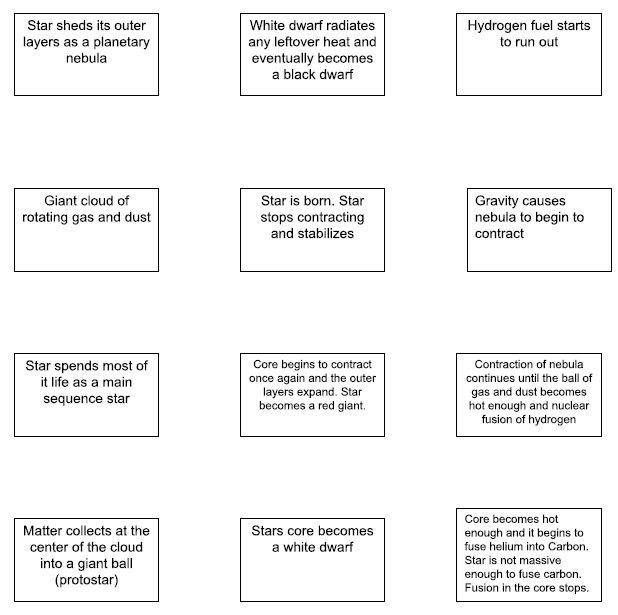-
Life Cycle of a Star
Introduction: Like anything in nature, stars have a life cycle - they are born, live, and die. The destiny of a star depends upon its mass. In this activity, you will identify key vocabulary words that deal with the life cycle of a star, and you will assemble the stages of a star's life from beginning to end.
Procedure A: Match the words below with their correct definition. Place the word in the space provided next to each definition.
Each word will be used just one time. Feel free to use the glossary in our textbook.
A. the collapsed core of a dead low-mass star
B. a star still beginning to form. It is heated by the gravitational collapse of dust and gasses
C. violent explosion in which much of the mass of a star is blown away, and the core flares up into an intensely bright object
D. cloud of gas and dust in space
E. measures how bright a star would be in relation to the sun if all stars were the same distance from the observer
F. final mass-loss stage for a low-mass star in which the outer layers are ejected during the core collapse
G. process used by stars to generate energy
H. a dying star that has become large in diameter and cool on the surface while the core has shrunk and increased in temperature
I. collapsed core of the most massive stars. The object that has a gravitational pull so strong that not even light can escape
J. the mass that is left over after a supernova. The collapsed core of an intermediate to high-mass star
K. region of the H-R diagram that represents hydrogen fusing stars. A star spends 90% of its life in this region of the H-R diagram. It stretches from the upper left corner to the lower right corner of an H-R diagram
L. a chart that classifies stars according to their temperature and brightness
M. young neutron star with a strong magnetic field and rapid rotation that produces beams of radiation out of its magnetic poles
N. a dying star of extremely high luminosity and relatively cool surface temperature. The diameter is over 10,000 times that of our sun
Analysis and Conclusions
-
What determines how bright a star will be?
-
What determines how hot a star will be?
-
What differences would this cycle have if the star was much more massive than our sun?
-
Why didn’t Jupiter become a star?
-
Name a star found on the “H-R Diagram” that is currently at the stage our Sun is predicted to enter after it sheds its outer layers to form a planetary nebula.
-
What type of star is Polaris? What is its approximate temperature?
Is it more or less luminous than our sun?
Directions: Below, you will find several boxes, each with a different step in the life cycle of a star with a mass equivalent to our sun. Cut out each box and arrange them in order on the back of your analysis and conclusion questions. Use your journal and discuss with your partner the correct order for the life cycle of an average-sized star. Tape your pieces to your lab paper. Number your boxes from 1 to 12 in order from birth to death.

-

